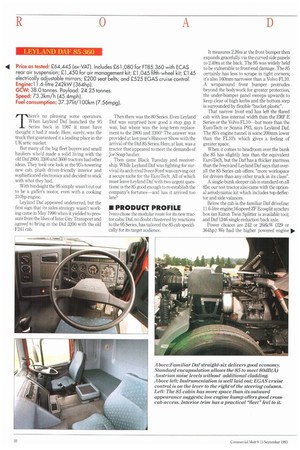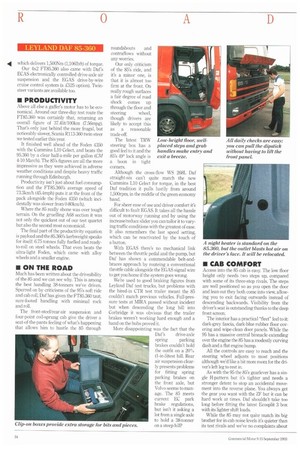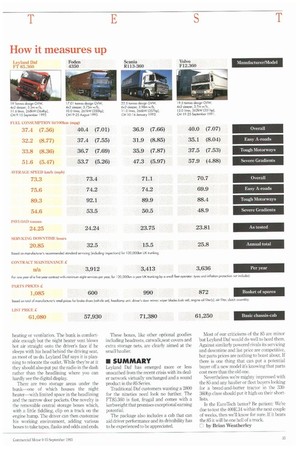Price as tested: £64,445 (ex-VAT). Includes £61,080 for FT85.360 with
Page 36

Page 38

Page 39

If you've noticed an error in this article please click here to report it so we can fix it.
ECAS rear air suspension; £1,450 for air management kit; £1,045 fifth-wheel kit; £145 electrically adjustable mirrors; £200 seat belts; and £525 EGAS cruise control. Engine:11.6-litre 242kW (364hp). GCVV: 38.0 tonnes. Payload: 24.25 tonnes. Speed: 73.3km/h (45.4mph). Fuel consumption: 37.371it/100km (7.56mpg).
There's no pleasing some operators. When Leyland Daf launched the 95 Series back in 1987 it must have thought it had it made. Here, surely, was the truck that guaranteed it a leading place in the UK artic market.
But many of the big fleet buyers and small hauliers who'd made a solid living with the old Daf 28CO, 3300 and 3600 tractors had other ideas. They took one look at the 95's towering new cab, plush driver-friendly interior and sophisticated electronics and decided to stick with what they had.
With hindsight the 95 simply wasn't cut out to be a gaffer's motor, even with a cooking 310hp engine.
Leyland Daf appeared undeterred, but the first sign that its sales strategy wasn't working came in May 1990 when it yielded to pressure from the likes of Inter City Transport and agreed to bring in the Daf 3200 with the old F241 cab. Then there was the 80 Series. Even Leyland Daf was surprised how good a stop gap it was, but where was the long-term replacement to the 2800 and 3300? The answer was provided at last year's Hanover Show with the arrival of the Daf 85 Series. Here, at last, was a tractor that appeared to meet the demands of Joe Soap haulier.
Then came Black Tuesday and receivership. While Leyland Daf was fighting for survival its arch rival Iveco Ford was carving out a secure niche for the EuroTech. All of which must leave Leyland Daf with two urgent questions: is the 85 good enough to re-establish the company's fortunes—and has it arrived too late?
• PRODUCT PROFILE
Iveco chose the modular route for its new tractor cabs: Daf, no doubt chastened by reactions to the 95 Series, has tailored the 85 cab specifically for its target audience. It measures 2.26m at the front bumper then expands gracefully via the curved side panels to 2.49m at the back. The 95 was widely held to be vulnerable to front-end damage. The 85 certainly has less to scrape in tight corners; it's also 160mm narrower than a Volvo FLIO. A wraparound front bumper protrudes beyond the bodywork for greater protection, the under-bumper panel sweeps upwards to keep clear of high kerbs and the bottom step is surrounded by flexible "bucket plastic".
That narrow front end has left the flared cab with less internal width than the ERF E Series or the Volvo FL10—but more than the EuroTech or Scania P93, says Leyland Daf. The 85's engine tunnel is some 200mm lower than the FL10's which gives a feeling of greater space.
When it comes to headroom over the bunk the 85 has slightly less than the equivalent EuroTech, but the Daf has a thicker mattress than the Iveco and Leyland Daf says that overall the 85 Series cab offers: "more workspace for drivers than any other truck in its class".
A single-bunk sleeper cab is standard on all 85s; our test tractor also came with the optional aerodynamic kit which includes top deflector and side valances.
Below the cab is the familiar Daf driveline; 11.6-litre engine;16-speed ZF Ecosplit synchro box (an Eaton Twin Splitter is available too); and Daf 1346 single-reduction back axle.
Power choices are 242 or 268kW (329 or 364hp.) We had the higher powered engine II.
• which delivers 1,500Nm (1,106Ibft) of torque.
Our 4x2 FT85.360 also came with Daf's ECAS electronically controlled drive-axle air suspension and the EGAS drive-by-wire cruise control system (a £525 option). Twinsteer variants are available too.
• PRODUCTIVITY
Above all else a gaffer's motor has to be economical. Around our three-day test route the FT85.360 was certainly that, returning an overall figure of 37.41it/100km (7.56mpg). That's only just behind the more frugal, but noticeably slower, Scania R113-360 twin-steer we tested earlier this year.
It finished well ahead of the Foden 4350 with the Cummins LIO Celect, and beats the 95.360 by a clear half-a-mile per gallon (CM 4-10 March). The 85's figures are all the more impressive as they were achieved in adverse weather conditions and despite heavy traffic running through Edinburgh.
Productivity isn't just about fuel consumption and the FT85.360's average speed of 73.3km/h (45.4mph) puts it at the front of the pack alongside the Foden 4350 (which incidentally was slower from 0-80km/h).
Where the 85 really shone was over tough terrain. On the gruelling A68 section it was not only the quickest out of our test quartet but also the second most economical.
The final part of the productivity equation is payload and the 85.360's kerbweight speaks for itself: 6.75 tonnes fully fuelled and readyto-roll on steel wheels. That even beats the ultra-light Foden, which came with alloy wheels and a smaller engine.
• ON THE ROAD
Much has been written about the driveability of the 85 and we can see why. This is among the best handling 38-tanners we've driven. Spurred on by criticisms of the 95's soft ride and cab roll, Daf has given the FT85.360 taut, sure-footed handling with minima] rock and roll.
The front-steel/rear-air suspension and four-point coil-sprung cab give the driver a seat-of-the-pants feeling of what's happening that allows him to hustle the 85 through roundabouts and contraflows without any worries.
Our only criticism of the 85's ride, and it's a minor one, is that it is almost too firm at the front. On really rough surfaces a fair degree of road shock comes up through the floor and steering wheel, though drivers are likely to accept this as a reasonable trade-off.
The latest TRW steering box has a good feel to it and the 85's 490 lock angle is a boon in tight corners.
Although the cross-flow WS 268L Daf straight-six can't quite match the new Cummins L10 Celect for torque, in the best Daf tradition it pulls lustily from around 1,500rpm, in the middle of the green economy band.
For sheer ease of use and driver comfort it's difficult to fault EGAS. It takes all the hassle out of motorway running and by using the increase/reduce slider you can tailor it to varying traffic conditions with the greatest of ease. It also remembers the last speed setting, which can be reactivated by the touch of a button.
With EGAS there's no mechanical link between the throttle pedal and the pump, but Daf has shown a commendable belt-andbraces approach by routeing a conventional throttle cable alongside the EGAS signal wire to get you home if the system goes wrong.
We're used to good braking figures from Leyland Daf test trucks, but problems with the hired-in CTR test trailer meant the 85 couldn't match previous vehicles. Full-pressure tests at MIRA passed without incident but when descending the long hill into Corbridge it was obvious that the trailer brakes weren't working hard enough and a hand on the hubs proved it.
More disappointing was the fact that the Daf's drive-axle spring parking brakes couldn't hold the outfit on a 20% (l-in-5)test hill. Rear air suspension clearly presents problems for fitting spring parking brakes on the front axle, but Volvo seems to manage. The 85 meets current EC park brake regulations, but isn't it asking a lot from a single axle to hold a 38-tonner on a steep hill?
• CAB COMFORT
Access into the 85 cab is easy. The low floor height only needs two steps up, compared with some of its three-step rivals. The steps are well positioned so as you open the door and lean out they both come into view, allowing you to exit facing outwards instead of descending backwards. Visibility from the driver's seat is outstanding thanks to the deep front screen.
The interior has a practical "fleet" fee] to it dark-grey fascia, dark-blue rubber floor covering and wipe-clean door panels. While the 95 has a massive central binnacle extending over the engine the 85 has a modestly curving dash and a flat engine hump.
All the controls are easy to reach and the steering wheel adjusts to most positions although we'd like a bit more room for the driver's left leg to rest in.
As with the 95 the 85's gearlever has a single H-pattern but it's tighter and needs a stronger detent to stop an accidental movement into the reverse plane. You always get the gear you want with the ZF but it can be hard work at times. Daf shouldn't take too long before fitting the latest Ecosplit 3 box with its lighter shift loads.
While the 85 may not quite match its big brother for in-cab noise levels it's quieter than its test rivals and we've no complaints about
heating or ventilation. The bunk is comfortable enough but the night heater vent blows hot air straight onto the driver's face if he sleeps with his head behind the driving seat, as most of us do. Leyland Daf says it is planning to relocate the outlet. While they're at it they should also put put the radio in the dash rather than the headlining where you can hardly see the digital display'.
There are two storage areas under the bunk-one of which houses the night heater-with limited space in the headlining and the narrow door pockets. One novelty is the removable central storage boxes which, with a little fiddling, clip on a track on the engine hump. The driver can then customise his working environment, adding various boxes to take tapes, flasks and odds and ends. These boxes, like other optional goodies including headrests, catwalk,seat covers and extra storage nets, are clearly aimed at the small haulier.
• SUMMARY
Leyland Daf has emerged more or less unscathed from the recent crisis with its dealer network virtually unchanged and a sound product in the 85 Series.
Traditional Daf customers wanting a 2800 for the nineties need look no further. The FT85.360 is fast, frugal and comes with a kerbweight that promises exceptional earning potential.
The package also includes a cab that can aid driver performance and its drivability has to be experienced to be appreciated.
Most of our criticisms of the 85 are minor but Leyland Daf would do well to heed them. Against similarly powered rivals its servicing and downtime and list price are competitive, but parts prices are nothing to boast about. If there is one thing that can put a potential buyer off a new model it's knowing that parts cost more than the old one.
Nevertheless we're mighty impressed with the 85 and any haulier or fleet buyers looking for a bread-and-butter tractor in the 330360hp class should put it high on their shortlists.
Is the EuroTech better? Be patient: We're due to test the 400E.34 within the next couple of weeks, then we'll know for sure. If it beats the 85 it will be one hell of a truck.
Cl by Brian Weatherley


























































































